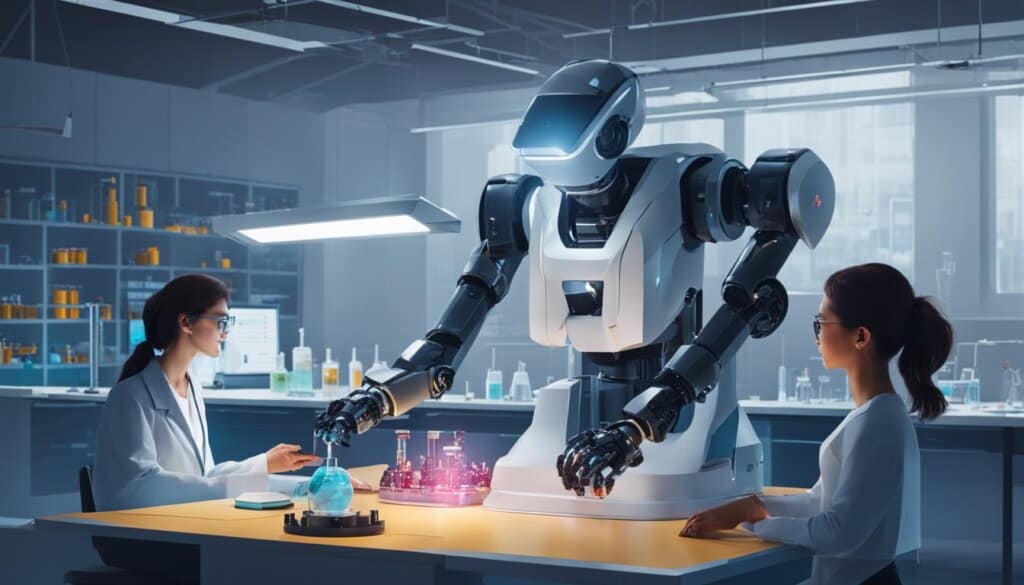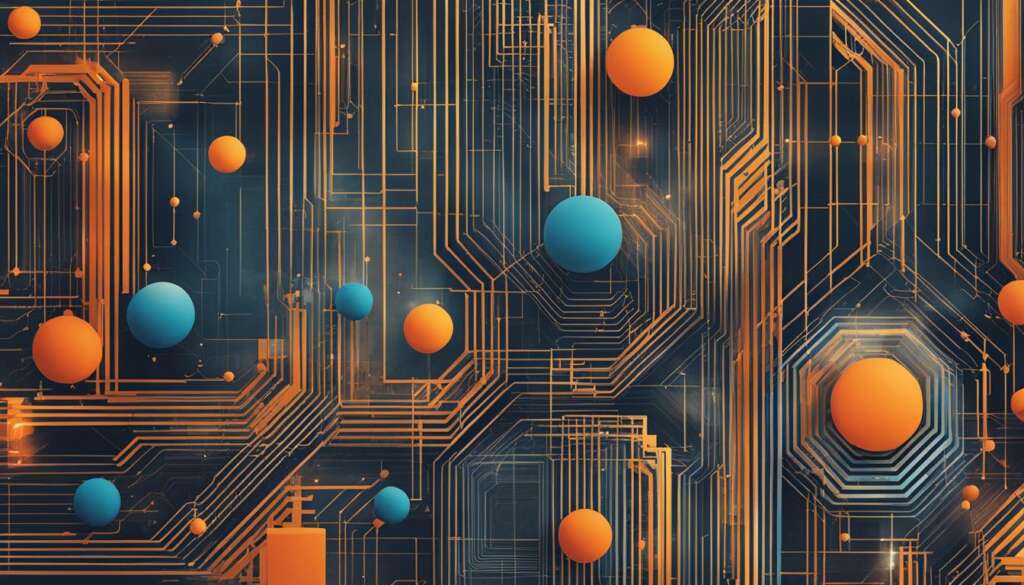Table of Contents
Welcome to our comprehensive guide on artificial intelligence (AI) and its applications in computer systems. AI refers to the simulation of human intelligence processes by machines, revolutionizing various industries and transforming the way we live and work. From automation to data analysis, AI has become an integral part of our everyday lives.
But what exactly is AI? In simple terms, AI involves creating computer systems that can mimic human intelligence, allowing them to perform tasks such as natural language processing, speech recognition, and machine vision. These systems analyze large amounts of labeled training data, identifying patterns and correlations that enable them to make accurate predictions.
AI is not limited to a specific programming language, but popular choices among developers include Python, R, Java, C++, and Julia. Its importance lies in its ability to automate tasks, improve business operations, detect fraud, and provide valuable insights based on big data analysis. AI can be categorized into weak AI, which is task-specific, strong AI, which aims to replicate human cognitive abilities, and super AI, which exceeds human capabilities.
Advantages of AI include its ability to perform detail-oriented jobs, save time in data-heavy tasks, increase productivity, deliver consistent results, and personalize customer experiences. However, it also has its limitations and potential disadvantages, including cost, technical expertise requirements, biased systems, limited generalization capabilities, job displacement, and ethical concerns.
In the upcoming sections, we will delve deeper into how AI works, its importance in various industries, the different types of AI, and its future prospects. So, let’s explore the fascinating world of artificial intelligence and discover its incredible potential.
How Does AI Work?
AI systems operate by ingesting large quantities of labeled training data and meticulously analyzing it for patterns and correlations. This process enables AI to develop algorithms that provide step-by-step instructions for completing specific tasks. AI programming focuses on cognitive skills such as learning, reasoning, self-correction, and creativity, enabling machines to simulate human-like intelligence.
Learning: AI systems acquire data and create rules, known as algorithms, to transform raw data into actionable information. By analyzing the training data, AI algorithms identify patterns and build a knowledge base for making predictions and decisions.
Reasoning: The decision-making process in AI involves selecting the most appropriate algorithm to achieve a desired outcome. AI systems evaluate different approaches and choose the one that maximizes the chances of success based on the given context and objectives.
Self-correction: To ensure accuracy and reliability, AI systems continuously fine-tune their algorithms. By learning from mistakes and feedback, AI can optimize its performance and adjust its decision-making processes accordingly.
Creativity: AI techniques, such as neural networks and statistical methods, enable machines to generate new content, including images, text, music, and ideas. AI systems simulate human creativity and produce novel outputs based on the patterns and knowledge accumulated from the training data.
AI excels in tasks that require analyzing large volumes of data quickly and precisely. It can outperform humans in repetitive and detail-oriented jobs where its computational power and speed give it a significant advantage. Furthermore, AI-powered systems offer valuable insights and predictions based on data analysis, contributing to enhanced decision-making in various industries.
The true potential of AI lies in its ability to analyze vast amounts of labeled training data, leading to accurate predictions and intelligent decision-making.
Applications for AI
The applications of AI span various fields, revolutionizing industries and enhancing efficiency:
- Business analytics: AI enables businesses to analyze big data efficiently, identify patterns, and make informed decisions. It provides insights into customer behavior, market trends, and operational performance.
- Healthcare: AI systems can analyze medical records, image scans, and genetic data to assist in diagnosis, treatment planning, and drug discovery.
- Automation: AI-powered robots and machines automate labor-intensive tasks, optimizing production processes and reducing human errors.
- Natural language processing: AI enhances language-related applications, such as virtual assistants, chatbots, and language translation tools.
The Power of AI in Making Predictions
One of AI’s most valuable capabilities is its ability to make predictions based on data analysis. By processing large amounts of labeled training data, AI systems can identify patterns and correlations that humans might miss. This predictive power is harnessed in various sectors, including finance, weather forecasting, stock market analysis, and sales forecasting.
AI models can analyze historical data, consider multiple variables, and generate accurate predictions that aid businesses and individuals in making informed decisions. The utilization of AI in prediction-making has transformed industries, improving their ability to foresee and react to trends, risks, and opportunities.
| Industry | AI Application |
|---|---|
| Finance | Risk assessment, fraud detection, algorithmic trading |
| Retail | Customer demand forecasting, inventory management, personalized recommendations |
| Transportation | Route optimization, autonomous vehicles, logistics management |
| Healthcare | Disease prognosis, patient monitoring, drug discovery |
| Marketing | Targeted advertising, customer segmentation, sentiment analysis |
Why is Artificial Intelligence Important?
Artificial Intelligence (AI) has the potential to revolutionize various aspects of our lives, work, and leisure. Its impact on business automation, improved operations, and generative AI techniques is significant. AI has emerged as a game-changer, capable of changing the way we live and work. By automating tasks that were previously performed by humans, AI has enabled businesses to streamline their operations, increase efficiency, and reduce costs. This has led to improved productivity and enhanced customer experiences.
One of the key advantages of AI is its ability to outperform humans in certain tasks, especially those that involve repetition and attention to detail. AI systems can complete these tasks quickly and accurately, minimizing errors and saving valuable time. This has contributed to improved efficiency and effectiveness in various industries.
Furthermore, AI has the power to process large volumes of data at a speed and scale that humans could never achieve. By analyzing massive datasets, AI can provide businesses with insights and patterns that were previously hidden or difficult to identify. This enables enterprises to make data-driven decisions and optimize their operations. AI has played a crucial role in transforming businesses like Alphabet, Apple, Microsoft, and Meta, where it is used to improve operations and gain a competitive edge.
The Potential of AI in Business Automation
The potential of AI in business automation is immense. AI technologies can automate tasks such as customer service, lead generation, fraud detection, and quality control. By utilizing AI-powered chatbots and virtual assistants, businesses can handle customer inquiries and provide support round the clock. This not only improves customer satisfaction but also reduces the need for human intervention in routine tasks.
Improved Operations and Efficiency
The use of AI in business operations has led to improved efficiency and effectiveness. AI algorithms can analyze large amounts of data, identify patterns, and make predictions that enable businesses to optimize their operations and make informed decisions. This has resulted in cost savings, increased productivity, and enhanced competitiveness.
Generative AI and its Creative Applications
Generative AI techniques are rapidly advancing and have opened up new possibilities in creative fields. AI can now generate realistic text, images, music, and other media, expanding the boundaries of human creativity. This has implications for industries such as advertising, design, entertainment, and art, where AI-generated content can bring new levels of innovation and artistic expression.
AI has the potential to transform how businesses operate, how we interact with technology, and how we experience the world around us. Its ability to automate tasks, improve operations, and generate creative content is reshaping industries and opening up new opportunities.
AI is no longer a futuristic concept; it is already transforming various sectors and changing the way we live and work. Understanding the potential of AI and harnessing its capabilities is crucial for businesses and individuals to stay competitive in today’s fast-paced digital landscape.

Advantages and Disadvantages of Artificial Intelligence
Artificial Intelligence (AI) offers numerous advantages, making it a valuable technology in various industries. One of its key advantages is its ability to perform detail-oriented jobs with great precision, often exceeding human capabilities. For example, AI-powered systems can analyze large datasets in data-heavy industries like banking, pharma, and insurance, significantly reducing the time required for complex data analysis tasks.
By automating labor-intensive processes, AI increases productivity and saves valuable time. It consistently delivers accurate and reliable results, minimizing errors that can occur due to human factors. Additionally, AI enables businesses to personalize content and messaging, enhancing customer satisfaction and engagement. Virtual agents powered by AI technology can provide uninterrupted service 24/7, ensuring prompt and efficient support.
However, it is essential to consider the disadvantages of AI as well. The cost of processing large amounts of data and implementing AI systems can be substantial. Additionally, AI technology requires deep technical expertise, limiting its accessibility to organizations without the necessary resources or specialized knowledge. The shortage of qualified workers proficient in AI further poses a challenge for businesses intending to adopt and implement AI solutions.
AI systems heavily rely on training data, which can introduce biases into their decision-making processes. These biases can reflect the biases present in the data used for training, resulting in potential unfairness or discrimination. Furthermore, AI systems may struggle to generalize their knowledge from one task to another, limiting their adaptability in diverse scenarios.
The potential impact of AI on employment is also a significant concern. As AI technology automates various tasks, it may lead to job displacement and potential unemployment in certain industries. This impact should be carefully managed and mitigated to ensure a smooth transition for affected workers.
Advantages of AI:
- Ability to perform detail-oriented jobs effectively
- Reduced time for data-heavy tasks
- Increased productivity and labor savings
- Consistent and accurate results
- Personalization of content and messaging
- Availability of 24/7 virtual agents
Disadvantages of AI:
- High processing costs
- Complexity and requirement of deep technical expertise
- Limited generalization capabilities
- Potential biases in decision-making
- Job displacement and unemployment concerns
It is crucial for organizations to carefully weigh the benefits and drawbacks when incorporating AI into their operations. By understanding and addressing these challenges, businesses can harness the power of AI while ensuring responsible and ethical use.
Strong AI vs. Weak AI
Artificial Intelligence (AI) can be classified into two main categories – weak AI and strong AI. Weak AI, also known as narrow AI, is designed to perform specific tasks and lacks full cognitive abilities. These AI systems are programmed to excel in a particular domain or task, such as image recognition, speech recognition, or AI chatbots. They are focused and efficient, delivering accurate results within their designated area of expertise.
On the other hand, strong AI, also referred to as artificial general intelligence (AGI), aims to replicate human cognitive abilities and exhibit intelligence that surpasses narrow AI systems. Strong AI possesses the capability to handle diverse tasks and apply knowledge acquired from one domain to another. These systems have the potential to autonomously find innovative solutions, think creatively, and adapt to various scenarios, similar to human intelligence. However, it is important to note that strong AI, as seen in movies and fiction, is still far from reality and remains in the realm of speculation.
In addition to weak and strong AI, there is a concept of super AI, which refers to AI systems that exceed human capabilities in various aspects. Super AI is speculated to possess extraordinary abilities such as predicting the future, creating scientific methods, and more. However, the development and realization of super AI are still subjects of ongoing discussion and research.
The 4 Types of Artificial Intelligence
Artificial Intelligence (AI) can be divided into four types based on its capabilities. Each type represents a different level of intelligence and functionality. Let’s explore these four types:
Type 1: Reactive Machines (No Memory)
Reactive machines are the simplest form of AI. They have no memory or ability to recall past experiences. These machines operate in the present moment, analyzing current data to make predictions and decisions. They excel at specific tasks but cannot learn from previous interactions or adapt their behavior based on past events. Reactive machines are primarily used in areas such as automated manufacturing and game playing.
Type 2: Limited Memory
AI systems with limited memory can access past experiences to inform their future decisions. These machines can learn from historical data, allowing them to improve their performance over time. Limited memory AI is capable of understanding context, recognizing patterns, and making predictions based on past events. Applications of limited memory AI include self-driving cars, recommendation systems, and fraud detection.
Type 3: Theory of Mind
Theory of mind AI embodies the ability to understand human intentions, beliefs, and emotions. These AI systems possess social intelligence and can predict and interpret human behavior. They are capable of inferring mental states and adapt their actions accordingly. Theory of mind AI has potential applications in customer service, virtual assistants, and social robots.
Type 4: Self-Awareness
Self-aware AI represents the highest level of artificial intelligence. These systems have a sense of self and current state awareness. They possess not only the ability to understand their environment and interact with it intelligently but also to recognize their own existence as separate entities. Self-aware AI is still largely theoretical and has yet to be fully realized.
Currently, only type 1 and type 2 AI systems are in practical use. While reactive machines and limited memory AI have significantly impacted various industries, the development of theory of mind and self-aware AI remains an ongoing pursuit in the field of artificial intelligence.
Examples of AI Technology and Its Applications
AI technology has revolutionized various industries due to its wide range of applications. Let’s explore some examples of AI in action.
1. AI in Automation
One significant application of AI is in automation. By leveraging AI-powered tools, businesses can streamline processes and expand the scope of tasks performed. AI automates repetitive and mundane tasks, freeing up human resources to focus on more complex and creative endeavors. From data entry and document processing to customer support and inventory management, AI automation plays a critical role in improving efficiency and productivity.
2. Machine Learning
Machine learning, a subset of AI, enables computers to perform tasks without explicit programming. This technology allows systems to learn from data, identify patterns, and make predictions or decisions. Machine learning algorithms can be categorized into supervised, unsupervised, and reinforcement learning. Businesses use machine learning in diverse fields, including predictive analytics, recommendation systems, fraud detection, and personalized marketing.
3. Machine Vision
Machine vision is another remarkable application of AI. It empowers machines with the ability to analyze visual information using cameras and digital processing. With machine vision technology, computers can comprehend and interpret images, enabling a wide array of applications. Machine vision finds applications in signature identification, medical image analysis, quality control in manufacturing, and autonomous vehicles, among others. This powerful tool enables machines to analyze visual data with precision and accuracy.
4. Robotics, Virtual Agents, and Language Models
AI technology extends beyond automation, machine learning, and machine vision. It includes robotics, virtual agents, and language models. Robotics combines AI and mechanical engineering to create intelligent machines that can perform physical tasks. Virtual agents, powered by AI, are used in customer support services, providing instant assistance and ensuring a seamless user experience. Language models based on AI are used for natural language processing, speech recognition, and language translation.
AI technology plays a pivotal role in industries such as finance, healthcare, customer support, and more. Its applications continue to grow, improving operational efficiency, enabling data-driven decision-making, and delivering better services to individuals and organizations alike.
These examples demonstrate the versatility and transformative potential of AI technology in our rapidly evolving world.
The Future of AI
The future of AI holds many possibilities and challenges. Over the past decades, there has been significant progress in AI, but machines still have limitations compared to human intelligence. Tasks such as language comprehension, commonsense reasoning, and learning new skills from limited examples pose challenges to AI.
The concept of artificial general intelligence, which aims to match human intelligence, may not be fully achievable. However, AI will continue to be refined and integrated into various industries to enhance efficiency and productivity.
As AI progresses, it is crucial to address ethical considerations, biases, and potential job displacement. Ongoing research and advancements in AI hardware, training courses, and open-source projects contribute to the widespread adoption of AI across different fields.
FAQ
What is artificial intelligence (AI)?
Artificial intelligence refers to the simulation of human intelligence processes by machines, specifically computer systems. It involves applications such as expert systems, natural language processing, speech recognition, and machine vision.
How does AI work?
AI works by analyzing large amounts of labeled training data, identifying patterns and correlations, and using these patterns to make predictions. It creates algorithms that provide step-by-step instructions for completing specific tasks.
Why is artificial intelligence important?
AI has the potential to transform how we live, work, and play. It automates tasks, improves business operations, and provides insights based on big data analysis. It is used in industries such as customer service, fraud detection, and quality control.
What are the advantages of AI?
AI has the ability to perform detail-oriented jobs, save time in data-heavy tasks, increase productivity, deliver consistent results, and personalize customer experiences.
What are the disadvantages of AI?
Disadvantages of AI include cost, technical expertise, biased systems, limited generalization capabilities, job displacement, and potential ethical concerns.
What is the difference between weak AI and strong AI?
Weak AI, also known as narrow AI, is designed to perform specific tasks and lacks full cognitive abilities. Strong AI, or artificial general intelligence (AGI), aims to replicate human cognitive abilities and can perform various tasks beyond the limitations of weak AI.
What are the different types of AI?
AI can be categorized into reactive machines, limited memory, theory of mind, and self-awareness based on its capabilities. Currently, only reactive machines and limited memory AI systems are in practical use.
What are some examples of AI technology and its applications?
AI is incorporated into various technologies such as automation tools, machine learning, machine vision, robotics, virtual agents, and language models. It is used in industries such as finance, healthcare, and customer support to improve efficiency and provide better services.
What does the future of AI hold?
While there has been significant progress in AI, machines still have limitations compared to human intelligence. The future of AI involves ongoing research and advancements, addressing ethical considerations, biases, and potential job displacement.







